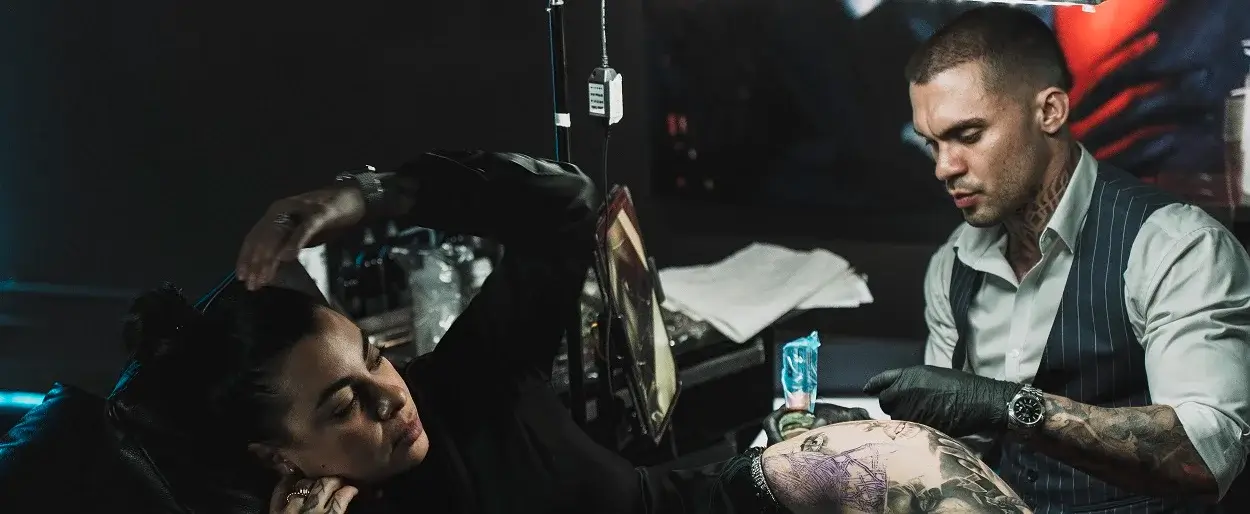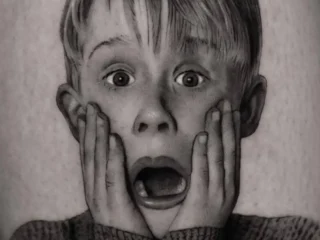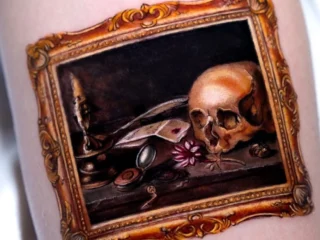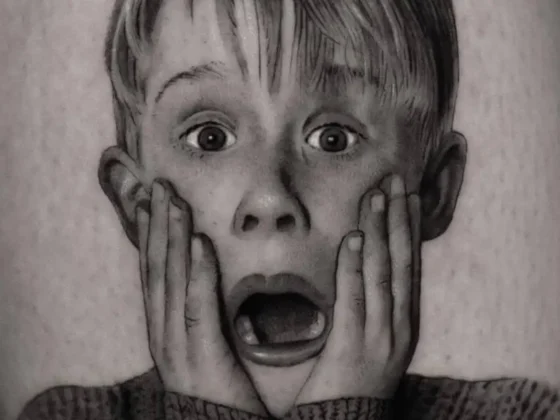Inked Mag Staff
January 7th, 2015
Breaking Fad: Inking the Antihero Walter White
Explore the dark and compelling world of Walter White in Breaking Bad. Uncover his loathsome traits and the reasons behind his tattooed fame.
Walter White is a murderer. Walter White is corrupt, sinister, greedy, and loathsome. He is in no way, shape or form the “good guy’” and yet, he is the driving force to root for in Breaking Bad. As an antihero, White is so compelling that he became one of the most tattooed faces of 2014.
The first time I ever paid attention to AMC‘s Breaking Bad was when tattoo artist Paul Acker posted progress shots of a sleeve inspired by the show to Instagram. It displayed the infamous RV, that pink teddy bear looking thing, and, of course, a portrait of a bald Bryan Cranston, the actor who plays White. The tattoo was pretty damn impressive as Acker’s work looks like a photograph or film still. Eventually I would come across more incredible portraits of White by the likes of tattooists Steve Wimmer and Matt Jordan and still be stuck questioning why this fictional character was so damn important. At the time that I first saw Acker’s sleeve Breaking Bad was still in full swing. People did not know what conclusions season five would bring, let alone how evil and corrupt White would become, yet they still wanted to get his face tattooed on them. Maybe they were hoping for his ultimate redemption; but as the boom of portraits continued after the show’s end, that theory and all hope of White’s redemption went out the window leaving us with a fully realized antihero.

The idea of the “antihero” is something that comes up a lot in film, television, and literature. It’s the figure in your high school English class that you have to “unpack” in order to fully get a grasp on the novel or Shakespeare play. The antihero is the character you feel compelled to root for even when they do horrible and unthinkable things. They are the characters you identify with because they don’t have the Clark Kent heart of gold. They have that flawed human nature and are not completely morally driven. They are characters that the audience can understand because we have been shown what motivates each antihero’s questionable actions. We give them the title antihero because it’s almost too hard for us to label them as the villains they really are.
A skilled hand is required to depict such a complex character, therefore, most tattoos of Cranston’s beautiful, bald head are typically pained or troubled images of White done by highly talented artists. Artists with waitlists who charge hundreds of dollars by the hour, and probably have most of their clientele travel to reach them. These aren’t just “good” tattoos. Most Walter White tattoos are GREAT tattoos. Whereas many standard portraiture icons, like Marilyn Monroe, are seen as classic muses or take years to become figures with faces worth inking, White, a totally fictional character, simply took off over night. So what about a high school teacher who makes blue meth was so intriguing to both a wide range of clients as well as esteemed portraiture gurus?

There’s something inherently relatable about White that makes him such an empathetic character. I have no problems watching White fall out of sorts when he realizes he’s “wasted” 50 years of his life to die unhappy and unsuccessful (by his own set standards). The 99% is a pre-Heisenberg Walter White. The constantly being outdone, outperformed struggle that stems in middle-class American life is all too present in Breaking Bad and therefore the main reason as to why we can accept White for who he starts off as and who he becomes. Throughout the years the media has seen this happen with popular characters like Othello’s Iago and Chuck Palahniuk’s Tyler Durden, but none so modern and hard hitting as Walter White.
Tattoos of White are almost always images of White CONFLICTED. You never see tattoos of White happy. He’s never angry. He’s never sad. When we look at modern media figures, it’s these conflicted quintessential antiheroes that have been sticking out significantly in the past decade. We remember the actions of Cranston’s character in two parts, when he’s family man Walter White and when he’s the notorious meth cook Heisenberg. We watch two-men-in-one both get into the meth business in order to save and provide for his kids’ future and then endanger loved ones in order to serve his own personal gain. You can’t accurately depict White in a picture unless he is that raw, conflicted figure because throughout the entire series he is always at war with himself. You don’t expect him to ever make up his mind. That’s why watching him let Jane die in season two is nowhere near as cruel and upsetting as watching him finally be able and WILLING to tell Jesse in season five that he let Jane die. It’s around this point in the series that he finally becomes the full potential of a monster the show has built up to. In these moments the disconnect between what the character represents to the show as a whole and who the character is within the show becomes overly apparent, thus making White a seemingly interesting, divided face that might spark a portrait artist’s intrigue.

White is the overall face of the Breaking Bad fad. The character and the show are almost conversationally synonymous, whereas the monster Cranston portrays is a whole different entity. Perhaps people are just starting to get ink of things they like without searching for any deeper meaning. White is socially regarded as “cool” and “in” for the time being. He’s a pop culture success and the face of one of modern TV’s most watched programs. Maybe the fact that he’s a murderer is just overlooked in place of the idea of him as THE iconic character from a beloved show.
As the ratings have shown, the audience fully accepts that given the circumstances the average Joe, or pre-50-year-old White, could turn into this iconic, inkable antihero. He is both relatable and intriguingly worlds away. Not only does he represent one of the most dynamic characters on television, he represents one of the most well-received and popular shows on television. Whether fans with White tattoos are praising the show or simply reveling in the relatable, yet terrifying, qualities of this character, I’m not sure. However, it seems as if White tattoos are simply products of the time, a cultural fad embarked upon because it is currently relevant. And in doing so, we are displaying a dramatically different approach to the classic “icon” in favor of the modern antihero.
Check out other awesome articles like this one, here.
Editor's Picks
Bridging Classical Art and Modern Tattooing
Esteban Rodriguez brings the discipline of classical fine art to the living canvas of skin, creating hyper-realistic tattoos that merge technical mastery with emotional depth.
Show Your Ink Fashions Brings Custom Style to Tattoo Culture
Show Your Ink Fashions creates custom shirts designed to showcase your tattoos as wearable art, blending fashion with personal expression.
The Ultimate “Superman” Tattoo Roundup: Just in Time for Superman’s Return to Screens
With Superman’s big return to theaters, fans are revisiting some of the most iconic ink inspired by the Man of Steel.














